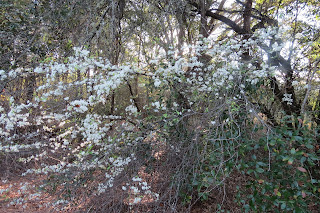This is a view of the trail looking to the east. Jan enjoys taking Winston for a walk along the pavement, and she keeps a sharp eye out for alligators, snakes and bobcats.
A view towards the west at the same position shown above. Note natural vegetation on each side of the trail. Also, the trail was constructed with geosynthetic mesh fabric, which has many advantages in this type of environment, including free flow of water from the bald cypress swamps to the left and the Rainbow River to the right. Geosynthetics could also reduce: construction costs, environmental damage and maintenance costs. The first photo shows how near the Rainbow River is. The second photo is the bald cypress swamp on the other side of the pavement. It is not unusual to see wildlife feeding within a few feet of either edge of the pavement.
Or, if you look UP, you may see a male and a female red-shouldered hawk. We saw this pair mating yesterday as we ate lunch. Very entertaining for the 10 seconds this usually lasts!
Mammals may also be seen along the trail. Armadillos, like the one below, are often active toward dusk. They use their snout to find invertebrates on and in the soil.
Ferns grow prolifically, more than 70 species in Florida. Sword ferns are often seen in thick clusters along the trail. The native sword fern, shown below, is the Nephrolepis exaltata. Back in the 19th century, an entrepreneurial pair of Floridian brothers brought this fern into horticultural production. Eventually, the horticultural variety became known as "Boston Fern". The great botany bloggers George Rogers and John Bradford tell the story here:
https://treasurecoastnatives.wordpress.com/2016/05/13/boston-fern-miami-fern-apopka-fern/
George has helped me a few times over the years. He writes in a most entertaining and educational manner. A personal note: back in 1977, I visited Fern City (Apopka), as I was in the tropical plant business. I had a personal tour of the Boston Fern production facility mentioned in George's blog.
This January, Jan and I also walked a few miles of the neighbouring 46 mile portion of the paved Withlacoochee pedestrian and bicycle trail at Citrus Springs. It is surprisingly different from the Dunnellon Trail as the following photos suggest. Both the Dunnellon Trail and the Withlacoochee Trail merge with hiking (only) trails which take you into the splendid Rainbow River State Park and the very large Halpata Tastanaki Reserve (which protects many local lakes and the north shore of the Withlacoochee over a large proportion of its length). Together, these trails are hundreds of miles of Florida nature, rarely interrupted by traffic or other human influence.
The beginning of the Withlacoochee Trail features uplands, with oaks and pines dominating the forest. Several of these large pines were a Turkey Vulture roost (above and below).
"I am SOOO pretty, don't you think so?"
Several of these shrubs were filled with white blooms. I have yet to identify them, as I have not seen this kind of shrub anywhere else. If you have an idea, do let me know. UPDATE, March 27, 2017: Ignore my previous update. This is Chickasaw Plum, Prunus angustifolia. It is an interesting and useful NATIVE shrub.
Read more about it here:
http://edis.ifas.ufl.edu/st504
Back on the Dunnellon Trail, there is a lot more moisture, from springs, the rivers and many cypress swamps. The Slash Pine (above) rules here, whereas Longleaf and Loblolly Pine is more dominant on the Withlacoochee Trail.
And, in this moist environment, many flowers, like the violet, may be found, and ferns, like the ubiquitous Royal Fern, below.
It is the birdlife that most people notice, though many small songbirds, like the Blue Gray Gnatcatcher, below...
and wading birds, like the White Ibis, below, and...

an adult and juvenile (white) Little Blue Heron in one of the marshes.....

and if you are very fortunate, a Limpkin might yell out its loud screech.

Jan and I hear Pileated Woodpeckers doing their "Wipeout" call constantly. I took a photo of this one last year:


Yesterday, while paddling in the Rainbow River, right beside the Trail, I saw this bird taking a drink. I wonder if the bill deformity will shorten its lifespan? I have seen deformities such as these in fish-eating birds in the Great Lakes. They are said to be caused by toxins. I wonder if there is something similar going on here?
Pileated woodpeckers love the oaks and pines of the Nature Coast. There are many species of Oak along both trails, but the Water Oak is found in numbers only along the rivers of the Dunnellon Trail. It is distinguished by its spoon-shaped leaves.



Heading back home, with the sun setting just after 5:45 this time of the year, the new Dunnellon Trail Bridge crosses the Withlacoochee, affording scenes like those below.

Next time, the Paynes Prairie Preserve, near Gainesville. Expect 'gators!

















No comments:
Post a Comment
Help with "Comments"
1) Click on "Comments" at the end of the blog entry that you wish to comment on.
2) Type your comment in the field provided.
3) Under your comment choose "Name/URL". Type your name (first and/or last names) in the box provided. Choosing "Name/URL" will ensure that you do not need to "register" before leaving a comment.
4) Click "Preview" to see how your comment will look on the site if you wish, otherwise skip to step 5.
5) Click "Publish" to submit your comment.
Please note that all comments are moderated so I will review them before they are published.
I look forward to receiving your comments.